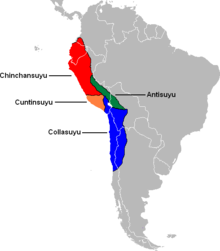Antisuyu
This article needs additional citations for verification. (June 2009) |

Antisuyu (
Antis is a collective term for the many varied ethnic groups living in the Antisuyu such as the
Description
Antisuyu is the second smallest of the suyus. It was located northeast of Cusco in the high Andes.[5] Indeed, it is the root of the word "Andes".[6] 'Anti' is the likely origin of the word 'Andes', Spanish conquerors generalized the term and named all the mountain chain as 'Andes', instead of only the eastern region, as it was the case in Inca era. According to some sources, Antisuyu was not the smallest of the Incan suyus, citing that its territory may have included the eastern slope of the Tahuantinsuyu as well as the adjoining tropical lowlands along the length of the empire.[1]
Antisuyu and Chinchaysuyu were bordered by a line west of the Inca road that ran from Cusco to Tambomachay.[5] The suyu was also separated from Collasuyu by the Huatanay River, which flowed through the city to the eastern end of the valley.[5]
Most of the lowland jungle was not part of Tawantinsuyu. Only the jungle region could not be dominated by the Incas, given that they could not colonize the jungle region. Arguably, the first organized and planned naval action of
The region of Antisuyu was the final retreat of the Neo-Inca state as they fled Spanish conquest. Notable among the Inca settlements here were Vilcabamba, and Vitcos. It is also thought that the mythical city of Paititi may exist somewhere within this region. Historian Andrew Nicol published research in 2009 in which he concluded that the existence of a city such as Paititi is possible within the Peruvian Amazon Basin.[8] Research as recent as 2016 by Vincent Pélissier provides a possible location for the lost city to the northeast of Vilcabamba.[9]
Annexation
Antisuyu was previously not part of the Incan empire. It was later conquered to address the problem of the shrinking space for crops along the coastal region of the empire.[10]
Wamani

Each suyu was divided into wamani, or provinces. Antisuyu included the wamani of:[3][4]
- Campa
- Chunchos
- Cunibo
- Lare or Lari, whose people were “Incas by privilege”
- Machiguenga
- Omasayo or Umasuyu
- Paucartambo or Pawqartampu
- Piro
- Shipibo
- Vilcabamba or Willkapampa
See also
References
- ^ ISBN 978-0-7591-2362-5.
- ^ Teofilo Laime Ajacopa, Diccionario Bilingüe Iskay simipi yuyayk'ancha, La Paz, 2007 (Quechua-Spanish dictionary)
- ^ a b D’Altroy, Terence N. (2005). The Incas. Blackwell Publishing: Malden, p. 42-43, 86–89
- ^ a b Steward, Julian H. & Faron, Louis, C. (1959). Native Peoples of South America. McGraw-Hill: New York, p. 185-192
- ^ ISBN 978-0-292-79204-3.
- ^ D'Altroy, Terence N. (2005). The Incas. Blackwell Publishing: Malden, p. 86-87
- ISBN 9780292767027.
- ^ Andrew Nicol (2009). "Paititi: The Last Secret Of The Incas? A Critical Analysis Of The Legends Surrounding The Lost Inca City Of Gold" (PDF). International Journal of South American Archaeology (5).
- ^ Vincent Pélissier (2016). "The Discovery of Paititi Last Capital of the Incas". Vincent Pélissier. Retrieved 15 December 2021.
- ISBN 978-1-5475-2257-6.
13°9′16.03048″S 72°31′31.16348″W / 13.1544529111°S 72.5253231889°W
